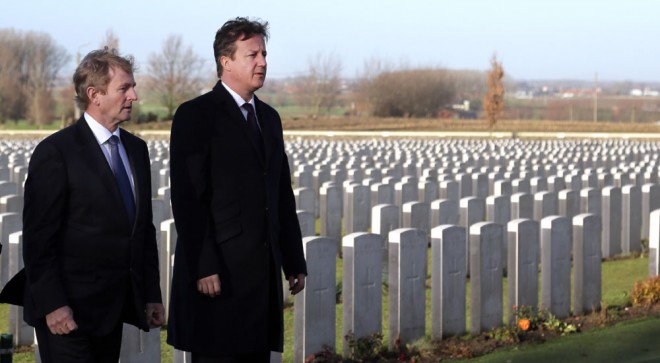World War I in numbers

British Prime Minister David Cameron, right, and Irish Prime Minister Enda Kenny walk through rows of World War One graves as they visit Tyne Cot Cemetery in Zonnebeke, Belgium on Thursday, Dec. 19, 2013. Both heads of state are visiting several World War One sites ahead of a four year Centenary program which begins in 2014. Tyne Cot is the largest Commonwealth war cemetery in the world in terms of burials. AP
PARIS – Millions of dead, millions more wounded, widowed and orphaned, the dizzying figures from World War I provide a small clue to the scale and horrors of the 1914-18 conflict.
The lack of reliable statistical tools at the time makes figures on the Great War difficult to pin down, accounting for sometimes substantial variations between historians.
The number of victims on the Russian and Ottoman sides remains particularly uncertain.
AFP has compiled the most widely accepted figures related to the conflict, and provided average estimates in cases where major discrepancies still exist.
MORE THAN 70 NATIONS: The figure is slightly anachronistic, since many of these nations had yet to gain independence from the six empires and colonial powers — Austria-Hungary, Britain, France, Germany, Russia and the Ottoman Empire — at the heart of the conflict.
Article continues after this advertisementA dozen independent nations went to war in the summer of 1914, the rest entering the conflict later like Italy in 1915 or the United States in 1917. Together the belligerent nations accounted for more than 800 million people, or more than half the world’s population at the time.
Article continues after this advertisementOnly around 20 countries were to remain neutral throughout the conflict, most of them in Latin America or northern Europe.
70 MILLION SOLDIERS: Some 20 million men were mobilized by the warring parties at the outset of war in 1914, a figure that rose as the war dragged on in time and expanded in scope.
Close to half of those mobilized were killed or injured.
Eight million men were mobilized in France, 13 million in Germany, nine million in Austria-Hungary, nine million in Britain and the British Empire (chiefly India), 18 million in Russia, six million in Italy, four million in the United States.
10 MILLION MILITARY DEAD, 20 MILLION INJURED
France: 1.4 million dead, 4.2 million injured
Germany: 1.8 million dead, 4.2 million injured
Austria-Hungary: 1.4 million dead, 3.6 million injured
Russia: 1.8 million dead, five million injured
Britain and British Empire: 900,000 dead, two million injured
Italy: 600,000 dead, one million injured
Ottoman Empire: 800,000 dead
Serbia suffered the worst losses proportionally to the size of its army, with 130,000 dead and 135,000 wounded — three quarters of its forces.
The emblematic battles of Verdun and the Somme, in 1916, left 770,000 and 1.2 million dead, wounded and missing, on both sides.
But the opening weeks of the war took the heaviest toll in human lives, with 27,000 French soldiers killed in a single day on August 22, 1914, the deadliest day in the history of the French army.
Seventy percent of the dead and wounded were hit by artillery fire. Between five and six million were mutilated for life. Poison gas, used on the battlefield for the first time, claimed 20,000 lives — relatively few in terms of the war’s overall toll — but was to loom large in the shared memory of the conflict, and with consequences for many of the survivors long after the war had ended.
MILLIONS OF CIVILIAN DEAD: In addition to military losses many millions of civilian lives were lost to the fighting. One million Armenians were massacred by Turkish forces, while some historians believe that up to five million people died in the Russian civil war and lingering conflicts that simmered on after 1918 in eastern Europe and Turkey.
A Spanish Influenza epidemic that broke out at the end of the war claimed another 20 TO 40 MILLION LIVES among populations often weakened by years of deprivation.
SIX MILLION PRISONERS OF WAR
20 MILLION LIVING UNDER OCCUPATION at the end of 1915, most of them in Belgium, France, Poland and Serbia, living under German, Austro-Hungarian and Bulgarian rule.
10 MILLION REFUGEES across Europe, most of them in Russia, Serbia, France, Belgium, Germany and Armenia.
THREE MILLION WAR WIDOWS, SIX MILLION ORPHANS
1.3 MILLION SHELLS FIRED, most of them on the Western Front, including 330 million fired by French artillery and 60 million during the Battle of Verdun alone.
10 BILLION LETTERS AND PACKAGES exchanged between fighters on the Western Front and their loved ones during more than 50 months of conflict.
180 BILLION DOLLARS: The estimated cost of the war for the seven main belligerents — Austria-Hungary, Britain, France, Germany, Italy, Russia and the United States. Two thirds of the cost was borne by the Allies and one third by the Central Powers. It was the equivalent of three to four times the combined GDP of the European powers, who were ruined by the conflict.
Related Story: